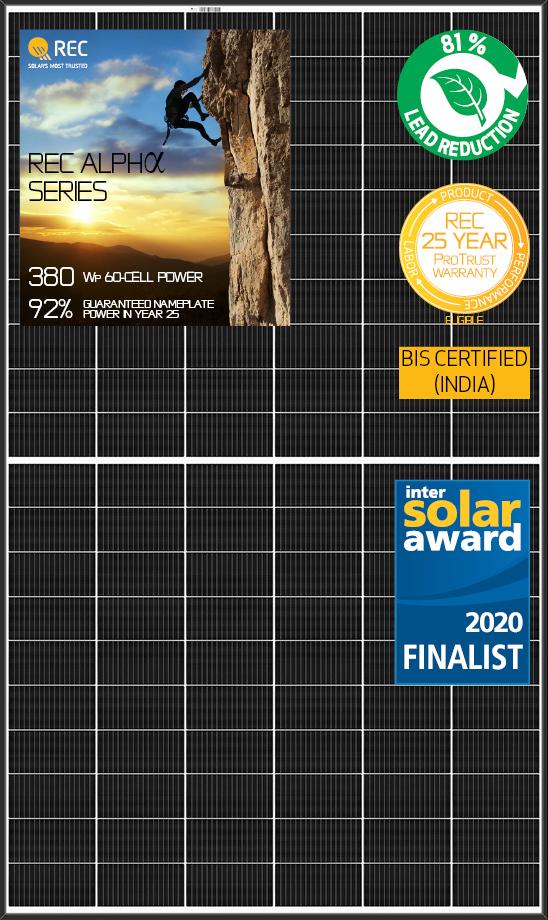 What have been the key recent developments at REC Solar? What are the different varieties of modules being offered by REC currently in the utility and rooftop solar segments?
What have been the key recent developments at REC Solar? What are the different varieties of modules being offered by REC currently in the utility and rooftop solar segments?
REC has always been a leading brand of cutting-edge technology and with the introduction of the Alpha Series, we have taken yet another bold leap. It was a gamechanger move, and this year at the Intersolar Europe, the Alpha Series was acknowledged as the most innovative solar panel by the Intersolar Award. It outdid competition where an undue emphasis is laid on raising watt-peaks and increasing wafer sizes. This is totally against true innovation as it’s just about increasing the form-factor and highly unsustainable in long run. It’s also creating this unnecessary pressure and complexity in the overall system dynamics, the long-term effects of which we are yet to be fully understood.
Alpha on the other hand is based on heterojunction technology, which is the future of PV as it combines the best of thin-film and N-type Monocrystalline technology. Apart from this, the Alpha Series also has half-cut cells, advanced interconnection technology and patented design along with REC’s award-winning Twin panel design. This combination is resulting in a leading power density of 217W/m2.
It is perfectly suited for the commercial, industrial rooftop segment, and ground mount and residential installations with space restrictions where system costs can be greatly compressed. Weighing only 23.5kg, the Alpha 72 Series also offers one of the thinnest frames (30mm) without compromising the mechanical integrity, thanks to its super-strong frame and additional support bars. The lightweight and thinner modules also mean convenient transportation and handling which reduces transportation costs and is ultimately more environmentally friendly.
with space restrictions where system costs can be greatly compressed. Weighing only 23.5kg, the Alpha 72 Series also offers one of the thinnest frames (30mm) without compromising the mechanical integrity, thanks to its super-strong frame and additional support bars. The lightweight and thinner modules also mean convenient transportation and handling which reduces transportation costs and is ultimately more environmentally friendly.
Globally, REC’s Alpha Series is already making waves in the residential markets of Australia, the US and Europe and popular with homeowners.
What kind of warranties does the company offer? How do your products address project reliability-related concerns?
At REC we have always been obsessed with quality and the great thing about that is that once you are certain about the consistency of quality and workmanship you can pass on the benefits down to your customers as well. And this is exactly what we did this year at the start, where we increased the Product warranties on all our products to 25 1 introducingREC’s comprehensive 25-years ProTrust Warranty which packs in 20+52 years of product warranty, 25 years performance warranty, and 25 years of labor warranty2
This is an industry-standard and we hope that with these wide-ranging warranties our customers will have peace of mind.
What have been the module price trends over the past two years globally and in India? What is your expectation for the near future? 
Module prices have been extremely volatile, to say the least, and they are a function of complex variable which go beyond simple demand and supply issues. Government and policy changes, tariffs, protectionist measures, and financing all play a big part. But lately, there has been a shift in India’s perception due to geopolitical issues and we surely see that the import tariffs will be the preferred choice in at least in the short-run.
Though it’s good to have those in place, it’s crucial that we can differentiate and discriminate based on country of origin. The popular myth that all solar panels are made in only one country needs to re-look and manufacturers which are global technology leaders with high-quality products should be incentivized to import rather than penalized for doing it.
What according to you are the outstanding issues in India’s manufacturing segment? How can they be addressed?
It’s surely true that a lot of capital is moving towards cleantech and it is a hot space to invest in, still, we have not seen the same amount of enthusiasm to invest in India as the government wanted with the manufacturing of solar from the global players. There were many MOUs signed but things have to still crystalize in reality.
Part of the problem is that the technology shift and solar-panel manufacturing is capital heavy investment whereas the existing module lines in India are not the latest technology in fact they are rather outdated. As far as the cell-technology goes, it’s still some time in the future.
For foreign manufacturers looking for OEM solutions having the right level of technology is the key as they have no intention to invest in old technology.
For the Indian manufacturers, the grass is green at the moment due to the domestic content requirement but they are not keen on investing in newer technologies due to prohibitively low tariffs and dominance of utility-scale, the investments which are happening globally are in the high and new generation technologies which has a relatively less uptake in the Indian market. Unless the Indian customer is going to demand better products and next-generation technology, the situation, by and large, would be the same.
However, there is some interesting demand in niche segments for companies like REC who have been successful in this same market despite all the challenges. Our long-term interest in India remains strong, and we see this is a matter of time when the large-scale residential market in India will tilt the scales for higher-quality products.
1Terms and Conditions Apply
2 Valid for installations by an REC Certified So lar Professional installer only

